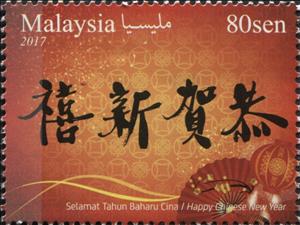Stamp: Chinese New Year (Malaysia 2017)
Chinese New Year (Malaysia 2017)
28 March (Malaysia ) within release Festive Greeting goes into circulation Stamp Chinese New Year face value 80 Malaysian sen
| Stamp Chinese New Year in catalogues | |
|---|---|
| Michel: | Mi: MY 2332 |
| WADP Numbering System - WNS: | WAD: MY 026.17 |
Stamp is horizontal format.
恭贺新禧 (Gong He Xin Xi) means Happy Chinese New Year. Chinese calligraphy writing is requires appreciation and valued as a form of cultural art that is quite different from other calligraphy.Also in the issue Festive Greeting :
- Stamp - Festive Greeting - Happy Deepavali face value 0.80;
- Stamp - Festive Greeting - Chinese New Year Greetings face value 0.80;
- Stamp - Festive Greeting - Selamat Hari Raya Aidil Fitri Greeting face value 0.80;
- Stamp - Festive Greeting - Lembaran Mini face value 5.00;
- Mini Sheet - Festive Greeting face value ;
- Souvenir Sheet - Combination of the greetings face value 5;
- Souvenir Sheet - Combination of the greetings face value 5;
- Stamp - Happy Deepavali face value 80;
- Stamp - Selamat Hari Raya Aidil Fitri face value 80;
- Stamp - Chinese New Year face value 80;
Stamp Chinese New Year it reflects the thematic directions:
Chinese New Year or the Spring Festival (see also § Names) is a festival that celebrates the beginning of a new year on the traditional lunisolar Chinese calendar. Marking the end of winter and the beginning of spring, observances traditionally take place from Chinese New Year's Eve, the evening preceding the first day of the year, to the Lantern Festival, held on the 15th day of the year. The first day of Chinese New Year begins on the new moon that appears between 21 January and 20 February
A festival is an event celebrated by a community and centering on some characteristic aspect or aspects of that community and its religion or cultures. It is often marked as a local or national holiday, mela, or eid. A festival constitutes typical cases of glocalization, as well as the high culture-low culture interrelationship. Next to religion and folklore, a significant origin is agricultural. Food is such a vital resource that many festivals are associated with harvest time. Religious commemoration and thanksgiving for good harvests are blended in events that take place in autumn, such as Halloween in the northern hemisphere and Easter in the southern.
A tradition is a system of beliefs or behaviors (folk custom) passed down within a group of people or society with symbolic meaning or special significance with origins in the past. A component of cultural expressions and folklore, common examples include holidays or impractical but socially meaningful clothes (like lawyers' wigs or military officers' spurs), but the idea has also been applied to social norms and behaviors such as greetings, etc. Traditions can persist and evolve for thousands of years— the word tradition itself derives from the Latin word tradere literally meaning to transmit, to hand over, to give for safekeeping. While it is reportedly assumed that traditions have an ancient history, many traditions have been invented on purpose, whether it be political or cultural, over short periods of time. Various academic disciplines also use the word in a variety of ways.



